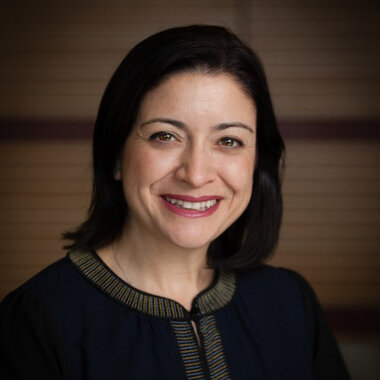Predicting relapse in childhood leukemia and expanding therapy options
Pediatric oncologist at Stanford Children’s Health
Davis has witnessed the growth of mass cytometry as a correlative technology, with increased interest in its use in clinical trials and with clinical trial specimens, such as for immune monitoring in CAR T cell trials.

There are many approaches to cancer treatment, but only those that succeed matter. Through decades of research, scientists and clinicians have been working to understand what characteristics add to the success of remission and what risk factors correlate with the probability of relapse. By determining which patients are at higher risk of relapse, we can better understand how to prevent it.
This is the goal of Kara Davis, DO, a pediatric oncologist at Stanford Children’s Health, who practices clinically and conducts translational research. A lot of what inspires her research is being able to ask questions in the lab based on her clinical experiences with pediatric leukemia, focusing on current lack of understanding about a particular pathobiology or response to therapy.
“We have learned a lot, especially on the genomic side, regarding genetic mutations, fusions and other events associated with risk of relapse or even initial development of leukemia. But we still don’t have a good handle on what happens when patients relapse who shouldn’t have, based on predictions. Or the opposite, when patients expected to relapse do not. Could we have saved them from intensified treatment and side effects, toxicity or other potential long-term adverse events? Ultimately, we need to do a better job of understanding someone’s initial relapse risk,” she explains.
Davis is investigating approaches that will provide more information from a patient’s leukemia cells and how to use this information in applying therapeutic interventions.
“Oncology is an exciting research area right now with the development of new therapies focusing on the immune response or targeting specific cell types. There is so much potential once we can identify who may be of most benefit from those therapies,” Davis says.
Why a cytometric approach is preferred and how that complements multi-omics
With relapse risk and therapy success as the driving forces of her research, Davis notes that having the ability to look at individual tumor cells with mass cytometry has been foundational.
In any cancer research setting, the heterogeneity observed across and even within tumors can be challenging. Single-cell analysis allows a focused view on the cells that can impact cancer progression. Davis explains this as the worker bees versus the queen bee. “I want to know the queen bee, which are the cells that I need to most care about, either because they are drug-resistant or because they are the ones that can regenerate the entire tumor. I want to find those cells.”
Conventional research surveys all tumor cells from a sample at the same time, using techniques such as bulk sequencing, where the resulting data is the average of all the cells in the tumor. Mass cytometry helps separate the signal from the noise in the tumor to find the cell populations that are of most interest and could have the most impact therapeutically, for the best outcome for the patient.
In a typical study, an initial survey analyzes the cell types present and characterizes their features, including surface marker features, intracellular signaling, transcription factors and metabolic features—anything that can be reliably queried with a well-validated and optimized antibody panel and analyzed by mass cytometry.
We could not have done 45 samples with AbSeq because it is cost- and time-prohibitive. Instead, we start with CyTOF, which is higher-throughput and much more cost-effective, to identify where we want to look and what patient samples we want to go after. ”
– Kara Davis, DO
The CyTOF® data can be further leveraged to identify more specific cell populations or proteins of interest. Complementary approaches, such as AbSeq, can be used to query those cells, pathways and networks to better understand how the cells are wired and what makes them susceptible to treatment.
In a current study involving CAR T cell therapy, Davis and team first performed a screen on a large group of patients, using mass cytometry to identify a population of cells of interest. They then designed an experiment based on the CyTOF data for whole transcriptome sequencing on a smaller subset of those patient samples.
“This has been a very nice complementary usage of the two approaches, where we can layer and integrate the data to get a lot of information. We could not have done 45 samples with AbSeq because it is cost and time prohibitive. Instead, we start with CyTOF, which is higher-throughput and much more cost-effective, to identify where we want to look and what patient samples we want to go after,” Davis says.
Davis has also used fluorescence cytometry as a complementary approach, which can work well if looking at a dozen or so parameters at a time. For those already familiar with the technologies, higher-parameter fluorescence-based platforms can be perceived as easy and high-throughput. However, this is countered by the need for a lot of optimization and time for panel design to ensure quality data and to separate overlapping signals. “The reduced or no compensation with CyTOF technology along with simple panel customization is really something I appreciate,” she says.
Moving standardized assays to clinical research and clinical trials
Over the last five years, Davis has witnessed the growth of mass cytometry as a correlative technology, with increased interest in its use in clinical trials and with clinical trial specimens, such as for immune monitoring in CAR T cell trials. She says there are a lot of exciting uses for the technology to become a translational tool as part of the overall toolbox to understand how we can do better for patients. Davis sees the latest instrument in the line of mass cytometers, the CyTOF XT™, with its fully automated startup and tuning programs as well as hands-free sample acquisition, as a key step toward widespread adoption in the translational space.
In fact, mass cytometry could be leveraged to more easily implement best practices for data standardization. Davis believes the ready-made panels of the Maxpar® Direct™ family of immune profiling assays can add value here. Multiple sites can use a standardized set of reagents on patients in different clinical contexts, which opens the possibility of sharing that data across clinical trials and patient types in search of relevant commonalities. Two consortia—IMPACC1 and CIMAC2—are already using the Maxpar® Direct™ Immune Profiling Assay™ in multi-site studies.
In her clinical studies, Davis is utilizing CyTOF technology to learn what processes could influence how cancer and immune cells affect eventual patient outcome. For example, she has investigated features of leukemia cells that might be pre-treatment risk factors for therapy failure. CyTOF analysis of leukemia cells before CAR treatment has identified cells associated with risk of relapse after CAR therapy. In a study identifying cell types resistant to glucocorticoid treatment, a standard, decades-old treatment for acute lymphocytic leukemia and prognostic for relapse, CyTOF analysis revealed resistant cell types and how they can be targeted.
Mass cytometry occupies a unique spot among single-cell analysis tools, enabling its use in basic understanding of all cells in a sample, focusing on specific cell types in relation to therapy response and creating profiles to predict therapeutic success.
“The beauty of CyTOF is that you can ask those complex questions from one tube of cells or one sample of cells. From one patient sample, we can look at leukemia cells, the T cell compartment, other surrounding cell types and how these cells interact. In that context, there is a lot of resolution into what’s happening, potentially even temporally when we can collect serial samples. This helps us understand the trajectory of multiple different cell types over the course of a treatment and how that relates to the eventual outcome of the patient,” Davis explains.
Davis hopes these types of approaches could potentially translate clinically, with the idea of changing the risk profiles of patients for the better. While many of these questions have long-term outlooks, the power of starting out with single-cell approaches is that they encourage impactful thinking and new ways to approach decades-old challenges.
The beauty of CyTOF is that you can ask those complex questions from one tube of cells or one sample of cells. ”
– Kara Davis, DO
Resources
References
Publications
Related Stories
Wendy Fantl, PhD

On the right path to better ovarian cancer diagnosis and treatment
Lori Turner, PhD

A quick pivot to COVID-19 research with CyTOF
Unless explicitly and expressly stated otherwise, all products are provided for Research Use Only, not for use in diagnostic procedures. Find more information here.
